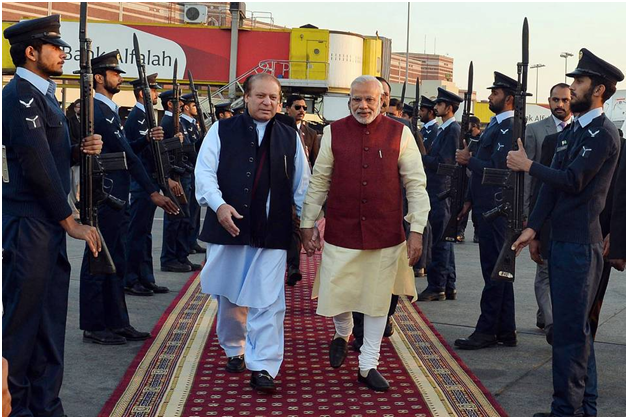India-Pak: From War To Peace In 25 Days
Holding hands: for how long?

NEW DELHI: The year began with speculation of ‘war’ with Pakistan, and has ended with a sudden visit by Prime Minister Narendra Modi to Lahore where he hugged and held hands with Prime Minister Nawaz Sharif, and set the Composite-turned-Comprehensive dialogue on course.
The first glimmerings of change were visible in Paris when the two respective Prime Ministers met for a few minutes on the sidelines. And events have since moved on with cascading effect.
What has happened in the last 2o days to turn the clock around? The reasons for not talking still dominate the India-Pakistan space. In that --from the Indian point of view--Pakistan has not given any new assurances on terrorism, maintaining as it has for a few years now that it is committed to combating terrorism, and is prepared to talk with India for joint cooperation. On Kashmir too, Pakistan has refused to back down and preferred to cancel the dialogue rather than give up the customary ritual of meeting the Hurriyat leaders in Delhi before or after every high level visit. And has made it apparent since then that Kashmir remains on top of its agenda for any dialogue with India.
Interestingly just hours before landing in Lahore PM Modi in a speech in Kabul indicated that there was no change in New Delhi’s assessment of Pakistan on the terror front. And his 40 minute speech to the Afghan Parliament contained several, barely hidden jibes at Pakistan when he said: “There are some who did not want us to be here. There are others who saw sinister designs in our presence here, There are others who were uneasy at the strength of our partnership. Some even tried to encourage us.” Pakistan has been crying foul for a long while now,and the reference was clearly to some of the claims it has been making against India.
Then again: "Afghanistan will succeed only when terrorism no longer flows across the border; when nurseries and sanctuaries of terrorism are shut; and, their patrons are no longer in business,” Again a reference to Pakistan and the long held Indian conviction of its involvement in nurturing and creating terror in the region.
Nothing has changed on the ground but there has been a flurry of top level activity from the Indian side. The two PM’s spoke at Paris. Then within days, again very secretly, the National Security Advisor Ajit Doval seen as a hawk on India Pakistan relations, rushed to Bangkok to meet with his Pakistan counterpart, now a man from the Army,Lt General Naseer Janjua who has replaced Sartaj Aziz. This was then followed by the visit of Minister of External Affairs Sushma Swaraj to Pakistan to attend the Heart of Asia summit. The two sides decided to start a Comprehensive Dialogue on all issues including peace and security, terrorism and Jammu and Kashmir. And now the famous Lahore drop by, where both PMs hugged and held hands and hugged again.
What has changed? Why? Questions continue to confound strategic experts even as television media rushes to embrace the development with no questions asked. For the success, or otherwise of this initiative, rests as much in the reasons behind the sudden rush to improve relations, as it does in the commitment of the two governments to move forward. For as and when the reasons falter or fade, the two will move back into the easier positions of talking, even if not waging, war.
One, on which there seems to be a consensus on both sides of the border, is global pressure. The United States in the midst of escalating terrorism, and President Barack Obama’s commitment to cut back, has been clear cut about its ‘zero tolerance’ for any conflict between India and Pakistan. The hardline approach of the Indian government has been a cause of concern, with repeated statements from Washington for peace between the two neighbours flagging the concern publicly. Sources said that it had been made very clear to PM Modi in Paris that it was time for India to move on the dialogue front rapidly as deadlines were running out.
Two, the Bihar elections where issues like Pakistan did not draw the vote. This seems to have resulted in introspection within, with a decision having been taken to move towards a dialogue with Pakistan. And address the pro-peace constituency, both globally and domestically for the moment at least.
The talks, like the scores of rounds that have gone before, will succeed if there is political commitment on both sides. Currently the talks are between the BJP led government in India and the Army led civilian administration in Pakistan, a combination that the strategic establishment on both sides believes is the only key to success. Envoys of Pakistan to India in the past have repeatedly told this writer that peace can only be ensured by the BJP and the Army respectively, although when asked whether both will be able to circumvent the limitations inherent in their own constituencies the answer has always been of silence.
Little has changed on the ground in terms of the outstanding issues since the year began. Recent history has, however, been erased with the Composite being renamed Comprehensive to legitimise a fresh round of dialogue whereby ground covered in the past is easily ignored. And both sides get the space to vacillate and delay yet again. Or conversely, to move forward to cement relations as never before although this remains under a big question marks still. Decisions taken such as the opening of consulates, visa relaxation, information flow in the past thus become meaningless as talks begin afresh without the encumbrance of old but vital decisions.
2016 will provide the answers to yet another India Pakistan journey towards the elusive goal of peace.



